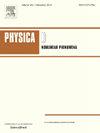具有非线性谐振腔的超材料中声波和光波之间的三比一内部共振
IF 2.7
3区 数学
Q1 MATHEMATICS, APPLIED
引用次数: 0
摘要
我们研究了两个广义振子之间的模态相互作用,这些振子表示声波和光波,作为波传播方程的解,通过被认为是细胞内谐振器增强的细胞承载二维结构的超材料。无阻尼时,系统为哈密顿系统,原点为具有两个不同线性频率的椭圆平衡。为了理解潜在的动力学,推导出作为物理参数函数的非线性频率的明确解析公式是至关重要的。在小振幅状态下(微扰情况下),我们对线性频率进行了一阶非线性校正。虽然这个解析表达式已经为非共振情况导出,但这里的兴趣放在共振或近共振情况下的波相互作用上。我们特别关注3:1的内部共振,这是一阶校正中唯一涉及的共振。然后,我们解决了具有挑战性的强共振情况,其中失谐相对于摄动参数很小。与标准方法不同,这里我们捕捉到了谐振动力学的全部复杂性,揭示了更丰富、更复杂的拓扑特征。利用哈密顿结构,利用微扰理论将系统转换为四阶的Birkhoff范式。这涉及到将系统转换为作用角变量,其中截断的四阶哈密顿量取决于作用,并且由于共振,取决于一个“慢”角。通过构造合适的非线性不接近恒等坐标变换,确定了新的辛作用角变量集。在这些变量中,所得到的系统是可积到高阶项的,这意味着它不依赖于角度,频率是由能量对动作的导数获得的。这种结构高度依赖于物理参数,需要对相肖像进行详细的案例分析,这揭示了多达六种拓扑上不同的行为。在每种情况下,我们描述了截断哈密顿量的非线性正规模式(椭圆/双曲周期轨道,不变环面)及其稳定和不稳定流形。对于计算,我们研究了具有周期性分布的duffing型谐振器的超材料蜂窝中的谐振波相互作用,具体解决了对带隙的非线性影响。更准确地说,考虑到超材料设计,我们的分析允许人们识别谐振器的模态质量和刚度值,使非线性在扩大带隙宽度方面的有益效果最大化。本文章由计算机程序翻译,如有差异,请以英文原文为准。
Three-to-one internal resonances between acoustic and optical waves in metamaterials with nonlinear resonators
We investigate the modal interactions between two generalized oscillators representing the acoustic and optical waves obtained as solutions of the wave propagation equations across a metamaterial conceived as cellular hosting 2D structure augmented by intracellular resonators. Without damping, the system is Hamiltonian, with the origin as an elliptic equilibrium characterized by two distinct linear frequencies. To understand the underlying dynamics, it is crucial to derive explicit analytical formulae for the nonlinear frequencies as functions of the physical parameters. In the small amplitude regime (perturbative case), we provide the first-order nonlinear correction to the linear frequencies. While this analytic expression was already derived for non-resonant cases, the interest is here placed on wave interactions in the context of resonant or nearly resonant scenarios. In particular, we focus on 3:1 internal resonance, the only resonance involved in the first-order correction. We then address the challenging strongly resonant case in which the detuning is small with respect to the perturbative parameter. Unlike standard approaches, here we capture the full complexity of resonant dynamics, revealing a richer, more intricate topological features. Utilizing the Hamiltonian structure, we employ Perturbation Theory to transform the system into Birkhoff Normal Form up to order four. This involves converting the system into action–angle variables, where the truncated Hamiltonian at order four depends on the actions and, due to the resonance, on one “slow” angle. By constructing suitable nonlinear and not close-to-the-identity coordinate transformations, we identify new sets of symplectic action–angle variables. In these variables, the resulting system is integrable up to higher-order terms, meaning it does not depend on the angles, and the frequencies are obtained from the derivatives of the energy with respect to the actions. This construction is highly dependent on the physical parameters, necessitating a detailed case analysis of the phase portrait, which reveals up to six topologically distinct behaviors. In each instance, we describe the nonlinear normal modes (elliptic/hyperbolic periodic orbits, invariant tori) and their stable and unstable manifolds of the truncated Hamiltonian. For the computations, we examine resonant wave interactions in metamaterial honeycombs with periodically distributed Duffing-type resonators, specifically addressing the nonlinear effects on the bandgap. More precisely, in view of the metamaterial design, our analysis allows one to identify the values of the modal mass and stiffness of the resonators, that maximize the beneficial effect of nonlinearity in enlarging the bandgap width.
求助全文
通过发布文献求助,成功后即可免费获取论文全文。
去求助
来源期刊

Physica D: Nonlinear Phenomena
物理-物理:数学物理
CiteScore
7.30
自引率
7.50%
发文量
213
审稿时长
65 days
期刊介绍:
Physica D (Nonlinear Phenomena) publishes research and review articles reporting on experimental and theoretical works, techniques and ideas that advance the understanding of nonlinear phenomena. Topics encompass wave motion in physical, chemical and biological systems; physical or biological phenomena governed by nonlinear field equations, including hydrodynamics and turbulence; pattern formation and cooperative phenomena; instability, bifurcations, chaos, and space-time disorder; integrable/Hamiltonian systems; asymptotic analysis and, more generally, mathematical methods for nonlinear systems.
 求助内容:
求助内容: 应助结果提醒方式:
应助结果提醒方式:


